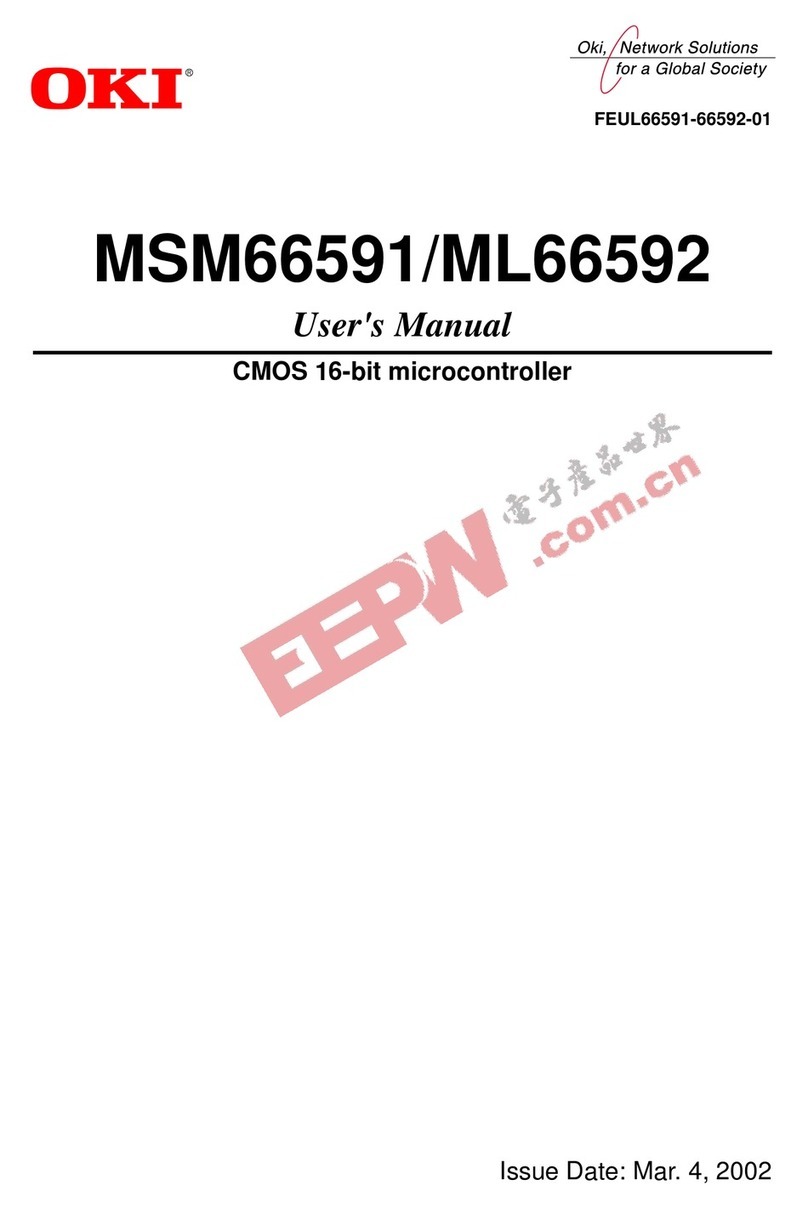
ML63611 User’s Manual
Contents
Contents – iii
Chapter 10. Ports (INPUT, I/O PORT) 10-1
10.1 Overview...................................................................................................................................................10-1
10.2 Ports List...................................................................................................................................................10-1
10.3 Port 0 (P0.0–P0.3).....................................................................................................................................10-2
10.3.1 Port 0 Configuration............................................................................................................................10-2
10.3.2 Port 0 Registers ...................................................................................................................................10-2
10.3.3 Port 0 External Interrupt Function (External Interrupt 5)....................................................................10-5
10.4 Port A (PA.0–PA.3)..................................................................................................................................10-7
10.4.1 Port A Configuration...........................................................................................................................10-7
10.4.2 Port A Registers ..................................................................................................................................10-8
10.5 Port B (PB.0–PB.3).................................................................................................................................10-11
10.5.1 Port B Configuration.........................................................................................................................10-11
10.5.2 Port B Registers.................................................................................................................................10-12
10.5.3 Port B External Interrupt Function (External Interrupt 0).................................................................10-17
10.6 Port C (PC.0–PC.3).................................................................................................................................10-19
10.6.1 Port C Configuration.........................................................................................................................10-19
10.6.2 Port C Registers.................................................................................................................................10-20
10.6.3 Port C External Interrupt Function (External Interrupt 1).................................................................10-25
10.7 Port E (PE.0–PE.3) .................................................................................................................................10-27
10.7.1 Port E Configuration .........................................................................................................................10-27
10.7.2 Port E Registers.................................................................................................................................10-28
10.7.3 Port E.3 External Interrupt Function (External Interrupt 2)..............................................................10-31
Chapter 11. Melody Driver (MELODY) 11-1
11.1 Overview...................................................................................................................................................11-1
11.2 Melody Driver Configuration ...................................................................................................................11-1
11.3 Melody Driver Registers...........................................................................................................................11-2
11.4 Melody Circuit Operation.........................................................................................................................11-4
11.4.1 Tempo Data.........................................................................................................................................11-5
11.4.2 Melody Data........................................................................................................................................11-6
11.4.3 Melody Circuit Application Example .................................................................................................11-9
11.5 Buzzer Circuit Operation........................................................................................................................11-10
Chapter 12. Serial Port (SIO) 12-1
12.1 Overview...................................................................................................................................................12-1
12.2 Serial Port Configuration..........................................................................................................................12-1
12.3 Serial Port Registers..................................................................................................................................12-3
12.4 Serial Port Operation Description...........................................................................................................12-12
12.4.1 Data Format.......................................................................................................................................12-12
12.4.2 Send Operation Description ..............................................................................................................12-13
12.4.3 Receive Operation Description .........................................................................................................12-19
12.5 Send/Receive Data LSB/MSB First Select.............................................................................................12-25
12.5.1 Selecting Send Data LSB/MSB First ................................................................................................12-25
12.5.2 Selecting Receive Data LSB/MSB First............................................................................................12-26
Chapter 13. LCD Driver (LCD) 13-1
13.1 Overview...................................................................................................................................................13-1
13.2 LCD Driver Configuration........................................................................................................................13-2
13.3 LCD Driver Registers...............................................................................................................................13-7
13.4 LCD Driver Operation............................................................................................................................13-10
13.5 Output Port Selection by Mask Option...................................................................................................13-11
13.6 Bias Generator Circuit (BIAS)................................................................................................................13-12
13.7 LCD Driver Output Waveform...............................................................................................................13-17




























